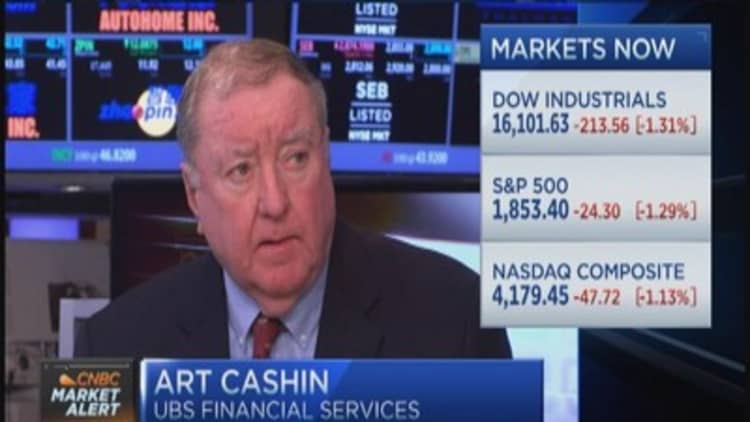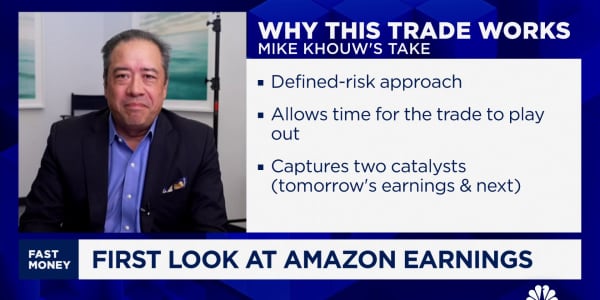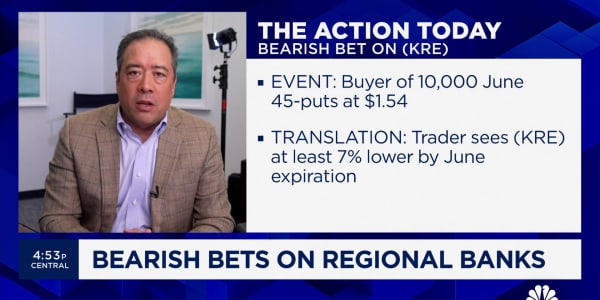
Investors are blaming an unprecedented lack of liquidity for Wednesday's gut-wrenching stock market open, which saw the fall as much as 2.2 percent from Tuesday's close, sent the VIX screaming to 28 and led to outsized moves in major stocks like Disney.
According to Eric Hunsader of Nanex, there were 179 "mini flash crashes" during the first 15 minutes of trading, which is the most since the Knight Capital Group fiasco in August 2012. Additionally, Hunsader reports that there were 68 trades in the S&P e-mini that moved that key futures contract 3 or more ticks. And Treasury futures, too, moved sharply as a result of low liquidity.
The definition that Nanex uses for a mini flash crash is that a stock sees 10 or more down ticks, for a price change exceeding 0.8 percent, within 1.5 seconds
Read More Weak US data spurs market's worst fears
"There was no liquidity at all, so it doesn't take a whole lot of size to really move the price," Hunsader told CNBC. But "some people come in, and they're used to buying or selling X-amount, and they're not paying attention. And X-amount now causes significant movements in price."
When this lack of liquidity collided with a great number of traders willing to get out at any price, markets got ugly.
"This was a pukage. People were putting in market order to sell on the open—'Just get me out'—without thinking," said Brian Stutland of Equity Armor Investments.
The issue, Hunsader said, is that high-frequency trading creates the appearance of liquidity. He gives the example of a trader who wants to buy 10,000 shares of a stock.
That order might get routed to two exchanges, but instead of the order getting completed with 5,000 shares traded on each exchange, the first trade of 5,000 shares will cause the other 5,000 share offered on the other exchange to dry up.
When these are market-order trades to buy or sell at the available price, the effect of this is a ricochet effect that leads to an outsized move.
This explains why not all of Wednesday morning's moves were to the downside.
In one of the day's most striking examples of a mini flash crash, Disney shares plunged 6.7 percent moments after the open before recovering.
However, Nike shares saw an outsized upside move, going from an opening price of $85.12 to $87.10 within three minutes, before plunging to $84.10 five minutes after that—and then recovering from there.
A similar dynamic explains the moves in the market as a whole.
Read MoreThe historical reason why stocks may fall further
"It usually take 2,000 contracts in the e-mini to move it a tick or 2—now 500 contracts easily moves it 3 ticks," Hunsader said, which is why 68 Wednesday morning trades caused moves of 3 ticks or greater. "Even bond futures are just at unprecedented lows in liquidity."
A spokesperson for CME Group, which runs the exchange on which the S&P e-mini futures are traded, offered no comment.
Manoj Narang, CEO of Tradeworx—a firm which engages in high-frequency trading—disputes Hunsader's account of the morning moves.
"A flash crash is when there's an out-of-control move that is outside the balance of possibility. This was very, very much within the bounds of normal market conditions—given the recent definition of 'normal,'" Narang said.
Notably, some traders are finding a bright side amid the chaos.
"Went it gets as awful as this, when there's blood in the streets, there are opportunities," said Bill Baruch of iiTrader.






